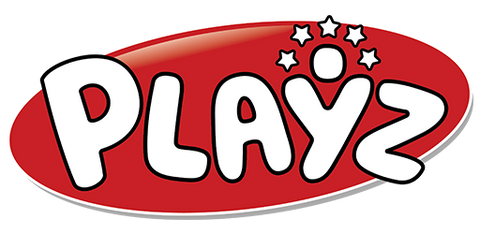
How to Increase Student Engagement: A Practical Guide for Educators and Parents
Let's move beyond the traditional signs of engagement, like quiet classrooms or hands shooting up in the air. Real engagement is a deep, active connection to learning—it's the spark of curiosity, the moment a lesson feels personal, and the drive to truly understand something new. It’s the critical difference between a student who is simply doing the work and one who is genuinely invested in it.
Moving Beyond Surface-Level Participation
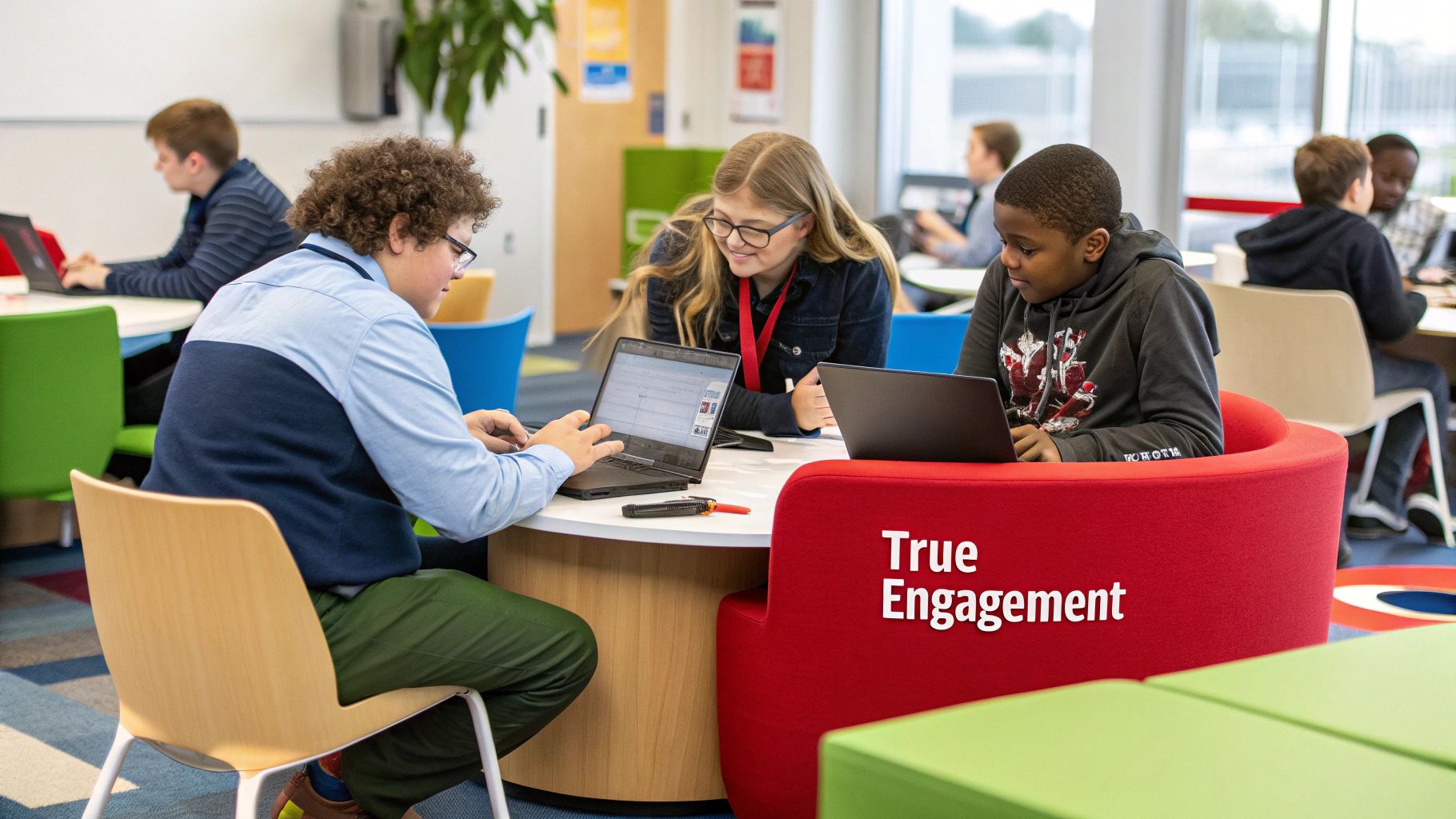
As educators and parents, we've all seen it: the student who follows directions perfectly but whose mind is a million miles away. This highlights a critical perception gap. One landmark study revealed that while 70% of elementary students felt engaged, a staggering 42% of their peers disagreed. That's a huge disconnect, showing just how differently engagement can be understood.
The truth is, authentic engagement isn't a single metric. It’s a blend of three distinct pillars. Understanding them is the first step toward creating an environment where kids don't just participate—they thrive.
What are the Three Pillars of Authentic Engagement?
For learning to stick, it needs to connect on three key levels: behavioral, emotional, and cognitive. Focusing on just one of these won't lead to lasting success.
- Behavioral Engagement: This is the easiest one to spot. It’s following rules, raising a hand, and turning in homework. It's crucial, but it’s often mistaken for the whole picture when it’s really just the starting line.
- Emotional Engagement: This pillar is about how a student feels about school—their connection to teachers, peers, and the classroom community. It’s the sense of belonging and positive attitude that makes them want to be there.
- Cognitive Engagement: This is the deepest and most powerful level. It’s the mental heavy lifting students do to wrestle with complex ideas, persist through challenges, and master tough skills. This is where strategic thinking and a genuine hunger to learn live.
“Student engagement refers to the degree of attention, curiosity, interest, optimism, and passion that students show when they are learning or being taught, which extends to the level of motivation they have to learn and progress in their education.”
To help you keep these pillars in mind, here’s a quick-glance table breaking them down.
Three Pillars of Student Engagement
| Type of Engagement | What It Looks Like | Actionable Strategy to Boost It |
|---|---|---|
| Behavioral | Following directions, participating in discussions, completing assignments on time. | Create clear, predictable routines and structures that make it easy for students to participate. |
| Emotional | Showing interest, feeling a sense of belonging, having a positive attitude toward school. | Build strong, positive relationships and foster a supportive, safe classroom community. |
| Cognitive | Asking thoughtful questions, persisting through challenges, connecting new ideas to old ones. | Design activities that spark curiosity and require problem-solving, not just memorization. |
This framework helps clarify what we're aiming for: a student who is present, positive, and mentally invested.
From Compliance to Commitment: A Mindset Shift
Shifting your focus from simply managing behavior to inspiring genuine investment is a game-changer. Instead of asking, "Are my students behaving?" try asking, "Are they intellectually curious? Are they emotionally connected to what we're doing?"
This mindset opens the door to far more effective strategies, moving the goalposts from compliance to commitment. An approach like what is discovery-based learning is built on this very idea. By nurturing all three pillars, you set the stage for strategies that build lasting enthusiasm and curiosity in every single student.
Spark Curiosity with Hands-On Learning
Let's be honest: passive listening is where curiosity goes to die. If you want to get students fired up about learning, you have to get their hands dirty. Learning needs to be an active, tactile experience where kids can touch, build, and actually see the results of their work.
This is the magic of hands-on, play-based learning—it turns abstract ideas into something tangible.
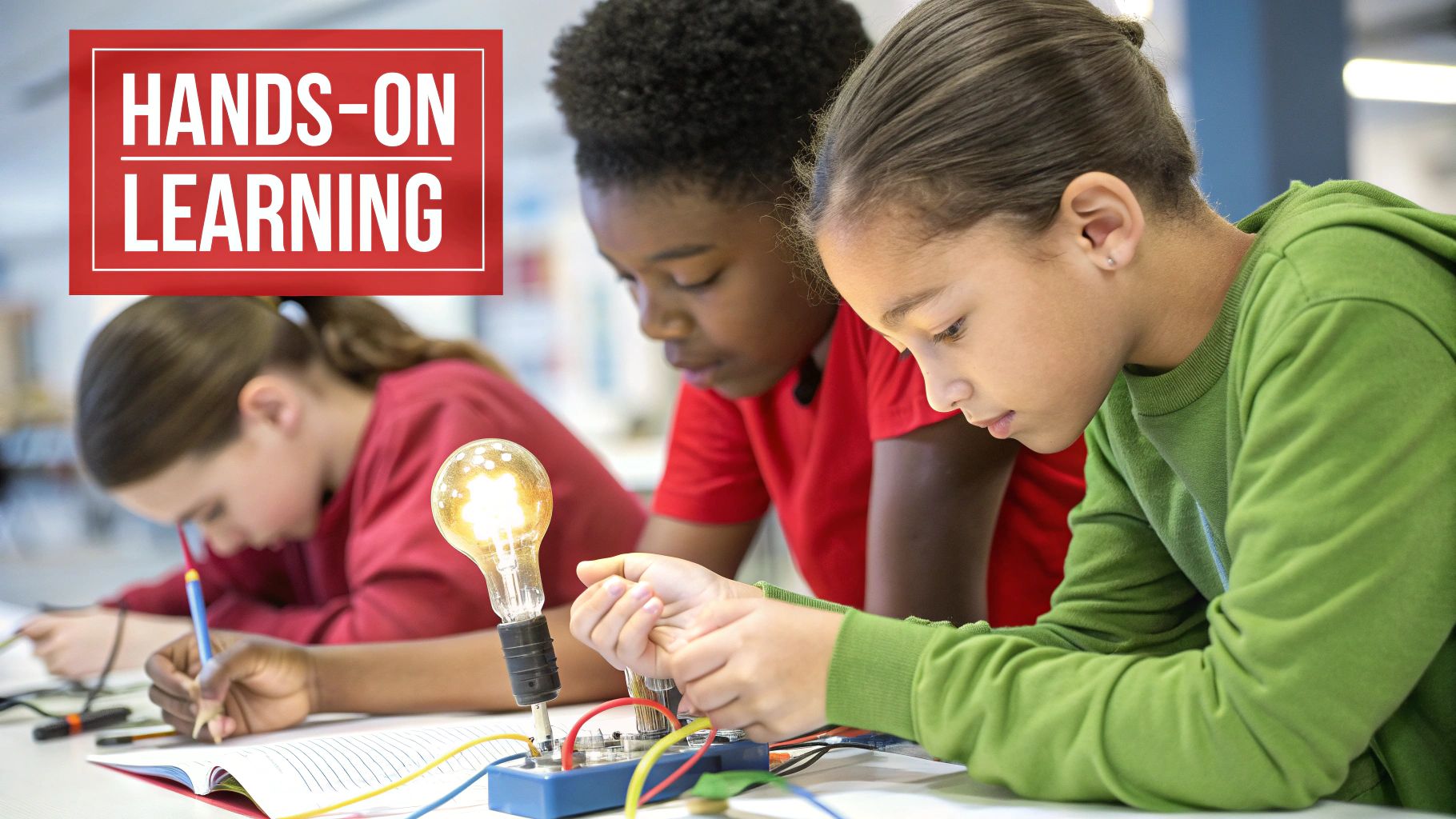
Think about it. You can talk about electrical circuits all day, but nothing compares to the moment a student connects that last wire and the bulb suddenly flashes to life. That genuine "aha!" moment is something a textbook can never deliver. This is exactly where tools like Playz science kits come in, shifting students from being quiet observers to active creators who are truly invested in what they're doing.
Turning Abstract Concepts into Concrete Results
The real power of hands-on activities is their ability to make concepts tangible. When a student physically interacts with materials, they aren't just memorizing facts; they're building deeper neural connections and understanding the why behind the what. One recent survey confirmed what many of us have seen firsthand: students are most excited when they get to learn through experiments and demonstrations.
Take chemical reactions. On a whiteboard, it can feel distant and theoretical. But give those same students a volcano-making kit where they mix the baking soda and vinegar themselves? Suddenly, they aren't just learning about chemistry—they're doing chemistry. They see the fizz, feel the reaction, and watch the "lava" flow.
The goal is to move from "show and tell" to "show and do." When students are physically involved, their natural curiosity takes over, and engagement skyrockets because they have a personal stake in the outcome.
This approach gives kids ownership. It empowers them to ask their own questions, test theories, and learn from mistakes in a low-stakes, high-impact way.
How to Integrate More Hands-On Activities in the Classroom
You don't need to overhaul your lesson plans to make this work. Small, consistent shifts toward interactive experiences can make a world of difference.
Here are a few practical, actionable ways to get started:
- Turn Lessons into Labs: Transform a standard science lesson into a mini-lab. Teaching the plant life cycle? Have students plant their own seeds and track the growth. The lesson becomes a living process, not just a diagram in a book.
- Embrace "Productive Failure": Encourage experimentation where the outcome isn't guaranteed. Building a simple machine that doesn't work on the first try teaches resilience and problem-solving far better than a perfect, pre-made example ever could.
- Use Themed Kits for Structured Fun: Sometimes, you need everything in one box. Science kits provide all the materials and guidance, removing logistical headaches. A kit focused on slime-making or crystal-growing gives students a clear goal while allowing for creative exploration within safe boundaries.
By framing learning as a hands-on adventure, you spark a genuine desire to discover. For more practical ideas, check out our guide on hands-on learning activities. These methods don’t just teach a subject; they teach students how to learn.
Building Connections Through Collaborative Projects
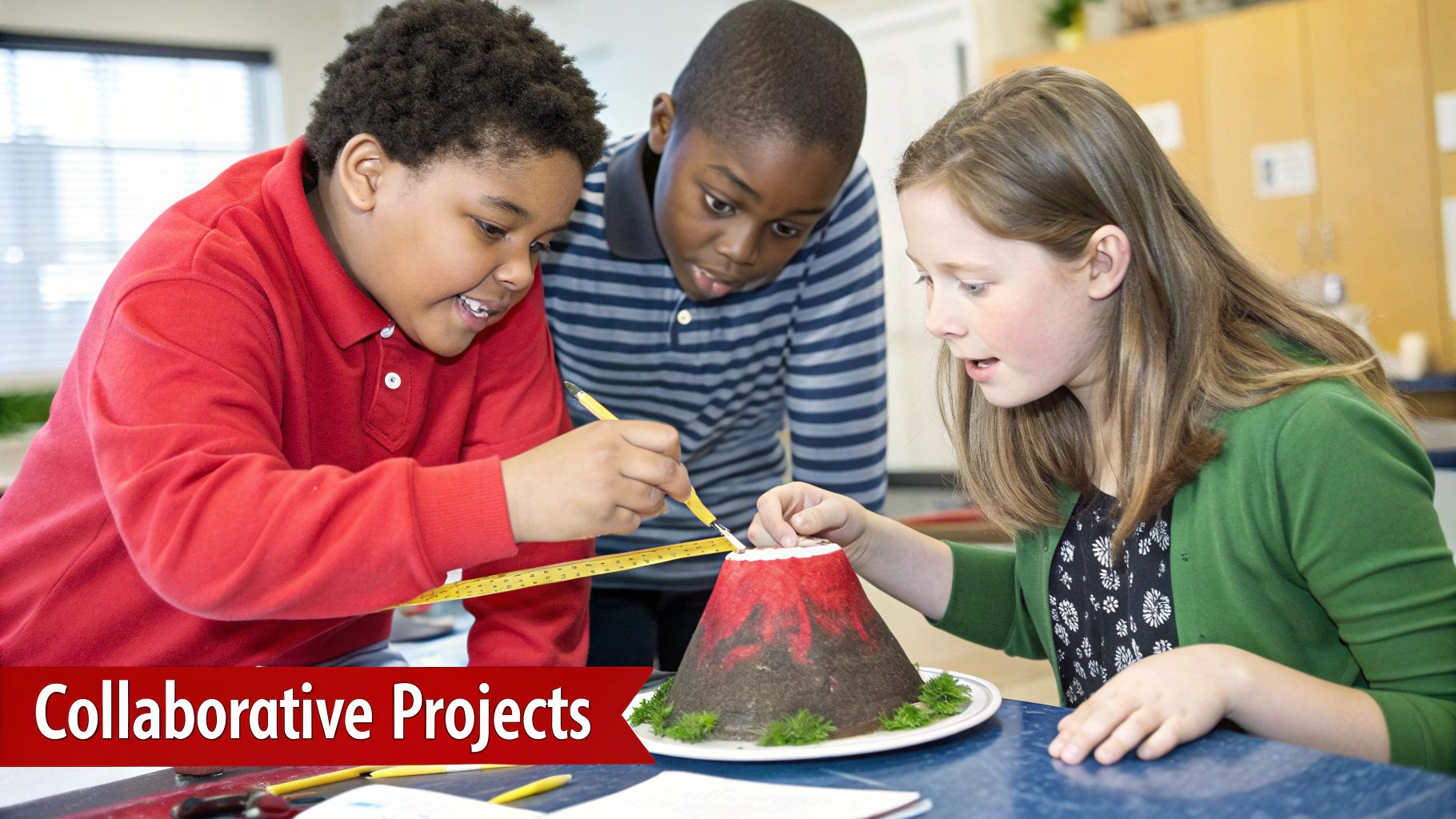
Here’s a secret every experienced educator knows: learning is rarely a solo sport. It's fundamentally social. I've seen it time and again—engagement skyrockets when students feel a genuine connection not just to their teachers, but to each other.
When you build a classroom culture that thrives on teamwork, something amazing happens. Passive listeners become active participants. They find a sense of belonging and purpose, and the entire energy of the room shifts for the better.
Designing Projects That Foster True Teamwork
The trick is structuring group work so it's more than just dividing up tasks. We've all seen projects where one kid does all the work while the others coast. True collaboration is about shared problem-solving and navigating different perspectives.
It’s about creating interdependence, where every student feels their contribution is vital for the team to succeed.
For example, when tackling a volcano eruption project with a chemistry set, instead of just telling a group to "build a volcano," assign specific roles:
- The Chemist: Responsible for accurately measuring and mixing the "lava" ingredients.
- The Geologist: In charge of researching volcano types and designing the model's structure.
- The Safety Officer: Ensures all procedures are followed correctly and the workspace is kept clean and safe.
With this structure, every student is accountable and actively involved. They aren't just learning about a chemical reaction; they're learning how a high-functioning team operates.
A core principle of increasing student engagement is creating a safe space where students feel comfortable sharing ideas, asking questions, and even making mistakes without fear of judgment. Collaborative projects are the perfect training ground for this.
From Group Work to Genuine Collaboration
Making the leap from basic group assignments to genuine collaboration takes intentional planning. It's not enough to just tell students to work together; we have to teach them how to do it effectively.
A great strategy is the "jigsaw" technique. Break students into small "home" groups, and each member becomes an "expert" on one specific subtopic. They then meet with experts from other groups to deepen their knowledge before returning to their home group to teach what they learned. Suddenly, every student is a valuable resource. It’s a huge confidence booster and ensures nobody can sit on the sidelines.
By incorporating dynamic play-based learning activities like these, you create an environment where teamwork becomes second nature and learning feels like a shared adventure.
Make Learning Relevant to Students' Lives
We’ve all heard it—the dreaded question from the back of the room: "When will I ever use this?" This isn't just a student trying to get out of work; it’s a sign that the connection has been lost. The moment a lesson feels irrelevant, motivation plummets.
The fix isn't just making things "fun." It's about demonstrating the real-world value of what they're learning. When you connect abstract ideas to their everyday lives, you can change their entire perspective from memorizing for a test to learning for life.
Bridging the Gap Between Curriculum and Their World
To make learning stick, start with what students already care about. A physics lesson on force and motion feels abstract until you frame it around the perfect arc of a basketball shot or the mechanics of landing a kickflip on a skateboard. Suddenly, it’s not just a formula; it’s the secret to getting better at something they love.
It’s the same with chemistry. An experiment can feel like a chore, but when you connect it to the science of baking the perfect cookie, everything changes. Understanding chemical reactions is no longer just for a lab—it’s for their kitchen. These connections grab their attention because they answer that all-important question: "Why does this matter to me?"
The goal is to reframe academic subjects as tools for understanding their own world. When students see a lesson as a way to explain their passions or solve a problem they actually have, their investment in learning goes through the roof.
Recent Gallup data from 'Voices of Gen Z' found that 56% of students rate their lives as 'thriving'—a positive jump in engagement. However, the report also highlights that many students still feel their classes aren't interesting or don't play to their strengths. The message is clear: we must make instruction more relevant.
Turning Abstract Theories into Practical, Hands-On Projects
Project-based learning is one of the best ways to show students how their education applies to real life. Instead of just reading about a historical event, why not have them create a short documentary or a podcast episode about it? This forces them to go beyond memorizing facts and think like researchers, storytellers, and producers.
Here are a few actionable ideas to get you started:
- The Vacation Budget Challenge: Ask students to plan a week-long vacation for a family of four on a strict budget. This project pulls in math, research, and critical thinking skills in an exciting, relatable scenario.
- The Community Garden Project: For a biology or environmental science class, have students plan and plant a small garden. This connects lessons on ecosystems and plant life directly to a tangible, positive outcome they can see and touch.
- The Invention Convention: Challenge students to identify a common problem they face every day and design a solution for it. This not only makes learning incredibly practical but also builds crucial problem-solving skills.
When you design projects that mirror real-world tasks, you give students a chance to see the immediate value of what they’re learning. These activities transform learning from a passive chore into an active, exciting journey.
Forging a Stronger Home-School Partnership
Genuine student engagement is a team sport. Real, lasting learning doesn’t stop when the school bell rings—it needs a strong bridge between the classroom and the living room. When parents and educators are on the same page, students see that their learning is valued everywhere, creating a powerful ecosystem that sustains motivation.
This partnership has never been more critical. The latest data on student disengagement is jarring: chronic absenteeism in U.S. schools has nearly doubled since before the pandemic. Today, about one in four students misses over 10% of the school year. The tough part? Many parents and caregivers don't realize there's a problem until it's significant.
Research from Brookings drives this point home, showing that family involvement is twice as predictive of a student's academic drive as their family's income. It's a clear signal that meaningful collaboration—focused on sparking curiosity, not just tracking attendance—is where the magic happens.
Moving Beyond the Parent-Teacher Conference
Building a solid home-school connection means thinking beyond the once-a-semester parent-teacher conference. It’s about creating an ongoing dialogue and giving families easy, low-prep ways to get involved.
For example, send home a simple "science challenge" for the week. It could be as easy as finding three different types of leaves in the backyard or building the tallest tower with marshmallows and toothpicks. These activities don't require expensive materials or a Ph.D., but they open the door for families to learn and discover together.
This infographic shows how learning can be framed within everyday life, connecting concepts in physics, chemistry, and practical skills to things kids already do.
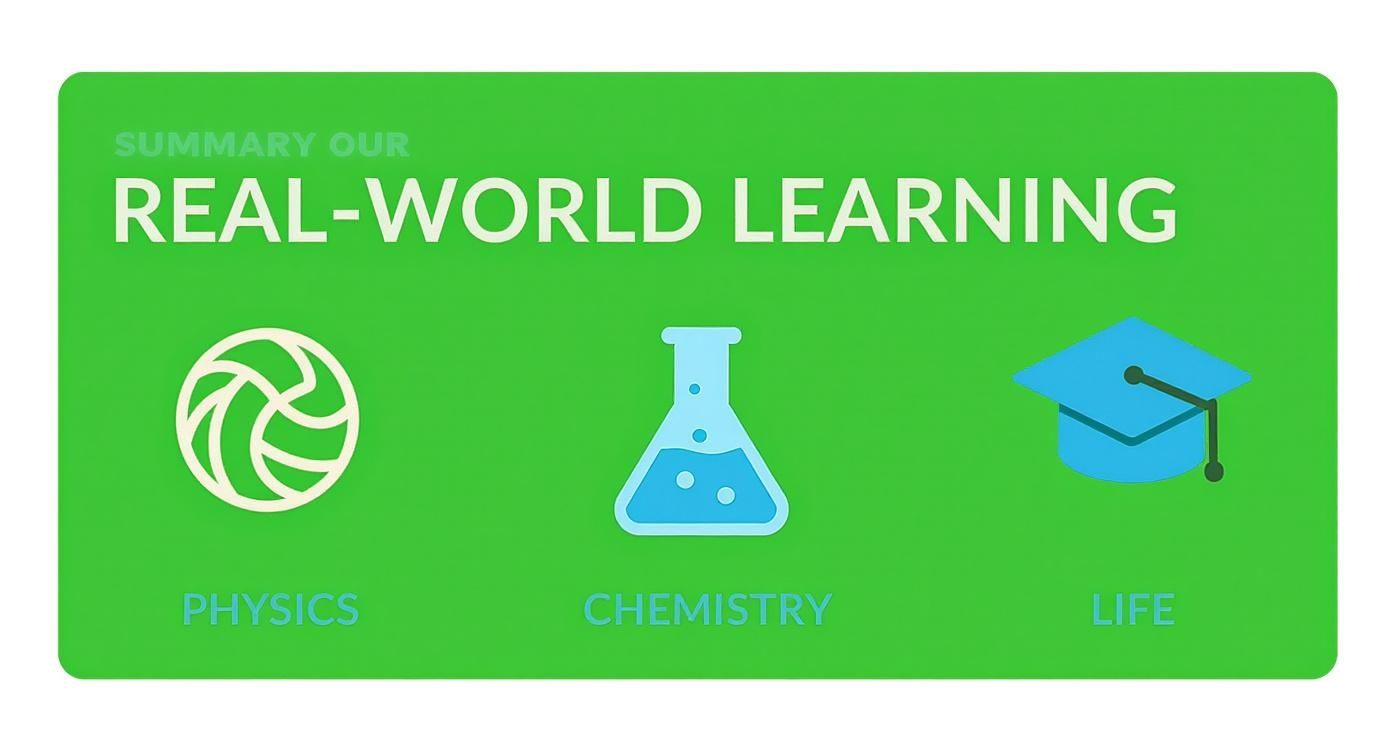
It’s a fantastic reminder that learning opportunities are everywhere, from the playground to the kitchen, making it easier for parents to support what’s happening in the classroom.
Practical Strategies for a Powerful Partnership
Creating this collaborative spirit is easier than you might think. It boils down to communication, accessibility, and shared goals. When you equip parents with the right tools, you empower them to become active partners in their child's education.
Here are a few actionable ideas to get started:
- Host a "Family Science Night" where families can team up on fun, hands-on experiments. This builds community and shows parents that science can be approachable and exciting.
- Create "Take-Home Tinker Kits" with simple materials like cardboard tubes and rubber bands. Challenge families to build a simple machine or solve a small engineering problem together.
- Share a weekly newsletter with a "Question of the Week" related to your current topic. This gives parents an effortless conversation starter to connect with their child about what they're learning.
The goal is to make learning a shared adventure. When students see their parents and teachers working as a team, they feel a stronger sense of support and motivation, which directly counters the disengagement that often leads to absenteeism.
Fostering this partnership creates a powerful support network that reinforces the value of curiosity. For parents looking for great at-home tools, exploring different types of STEM toys for kids can provide endless opportunities for family fun and discovery.
Home vs. School Engagement Strategies
This table offers a comparative look at actionable engagement strategies that can be implemented in both home and classroom settings to create a cohesive learning experience.
| Engagement Area | Classroom Strategy (Educator) | Home Strategy (Parent/Guardian) |
|---|---|---|
| Hands-On Projects | Organize a "Family Science Night" with interactive stations. Send home simple "Tinker Kits" with a weekly challenge. | Use a STEM kit or everyday items for a family building challenge. Cook a recipe together and discuss the science of cooking. |
| Inquiry-Based Learning | Introduce a "Question of the Week" in a class newsletter to spark dinner table conversations. | Ask open-ended questions like, "What do you think would happen if...?" or "How could we test that idea?" during play. |
| Real-World Connection | Plan a field trip (virtual or in-person) to a local science center or invite a guest speaker to discuss their STEM career. | Point out science in everyday life, like the physics of a swing set at the park or the biology of plants in the garden. |
| Communication | Use a class app to share photos of students engaged in activities. Send home conversation starters related to the curriculum. | Check in with your child about their "favorite part of science class" this week. Share any home discoveries with their teacher. |
By aligning efforts, both educators and parents can reinforce the same message: learning is an exciting, ongoing adventure that happens everywhere.
Answering Your Top Questions About Student Engagement
Figuring out what makes students tick can feel like solving a constantly changing puzzle. As educators and parents, we often face similar roadblocks when trying to boost engagement. Let's tackle some of the most common questions.
How Can I Keep Students with Different Learning Styles Engaged?
The secret isn’t to create a separate lesson for every learning style—that’s not practical. The magic happens when you build variety into your teaching over a week or a unit. This way, every student gets a chance to connect with the material in a way that clicks for them.
For example, you could kick off a topic with a captivating story (auditory learners), then dive into a hands-on experiment with a Playz kit (kinesthetic learners). Follow that with a short, dynamic video explaining the core concept (visual), and wrap up with a quick journal reflection (reading/writing). By mixing your methods, you create a classroom where every child has a chance to shine.
What Is the Single Most Important Factor for Engagement?
While many factors contribute, if I had to choose just one, it’s the student-teacher relationship. Hands down. When students feel that you see them, hear them, and care about them as individuals, their motivation to participate and learn skyrockets.
Your enthusiasm is infectious. Building genuine rapport and a positive, supportive classroom vibe is the foundation. Without it, even the most exciting activities can fall flat.
A fantastic, well-planned experiment can easily fail in a classroom that feels cold or impersonal. But a strong, trusting relationship? That can make even a simple worksheet feel important.
How Do I Know If My Engagement Strategies Are Actually Working?
Look beyond grades and test scores. True engagement shows up in the small things—the subtle shifts in a student's attitude and curiosity.
- Are they asking deeper questions that go beyond what’s on the test?
- Do they seem more willing to volunteer an idea, even if they aren't 100% sure it's right?
- Are you overhearing them discussing the topic at lunch or recess?
These are the real signs you're on the right track. You can also get a quick pulse-check with simple tools like Exit Tickets, where students jot down the most interesting thing they learned, or Quick Polls to get honest feedback on activities.
How Can I Compete with Phones and Screens?
Stop trying to compete—start integrating. Use technology for what it’s good at, like collaborative research or interactive simulations. But your superpower, the thing a screen can never replicate, is a tangible, hands-on experience.
A real science experiment that fizzes, bubbles, or pops creates a visceral memory that a YouTube video can't match. By strategically balancing focused tech time with unplugged, hands-on discovery, you create a learning environment that’s far more compelling than any single device.
Ready to bring the magic of hands-on learning to your classroom or home? The science kits and educational toys from Playz are designed to spark curiosity and make learning an unforgettable adventure.
Discover how Playz can transform your learning environment today!
